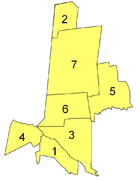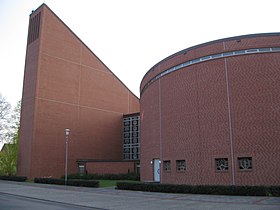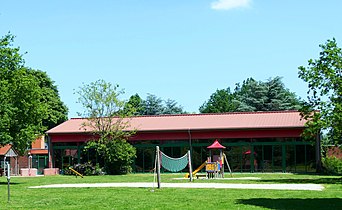
Lower Saxony is a German state in northwestern Germany. It is the second-largest state by land area, with 47,614 km2 (18,384 sq mi), and fourth-largest in population among the 16 Länder federated as the Federal Republic of Germany. In rural areas, Northern Low Saxon and Saterland Frisian are still spoken, albeit in declining numbers.
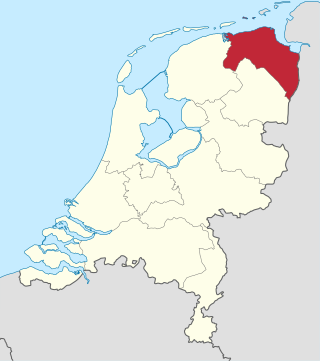
Groningen is the northeasternmost province of the Netherlands. It borders on Friesland to the west, Drenthe to the south, the German state of Lower Saxony to the east, and the Wadden Sea to the north. As of January 2023, Groningen had a population of about 596,000, and a total area of 2,955 km2 (1,141 sq mi).
Leer is a district (Landkreis) in Lower Saxony, Germany. It is bounded by the city of Emden, the districts of Aurich, Wittmund, Friesland, Ammerland, Cloppenburg and Emsland, and by the Netherlands.
Landkreis Emsland is a district in Lower Saxony, Germany named after the river Ems. It is bounded by the districts of Leer, Cloppenburg and Osnabrück, the state of North Rhine-Westphalia, the district of Bentheim in Lower Saxony, and the Netherlands.

Salzgitter is an independent city in southeast Lower Saxony, Germany, located between Hildesheim and Braunschweig. Together with Wolfsburg and Braunschweig, Salzgitter is one of the seven Oberzentren of Lower Saxony. With 101,079 inhabitants and 223.92 square kilometres (86.46 sq mi), its area is the largest in Lower Saxony and one of the largest in Germany. Salzgitter originated as a conglomeration of several small towns and villages, and is today made up of 31 boroughs, which are relatively compact conurbations with wide stretches of open country between them. The main shopping street of the young city is in the borough of Lebenstedt, and the central business district is in the borough of Salzgitter-Bad. The city is connected to the Mittellandkanal and the Elbe Lateral Canal by a distributary. The nearest metropolises are Braunschweig, about 23 kilometres to the northeast, and Hanover, about 51 km to the northwest. The population of the City of Salzgitter has exceeded 100,000 inhabitants since its foundation in 1942, when it was still called Watenstedt-Salzgitter. Beside Wolfsburg, Leverkusen and Eisenhüttenstadt, Salzgitter is one of the few cities in Germany founded during the 20th century.
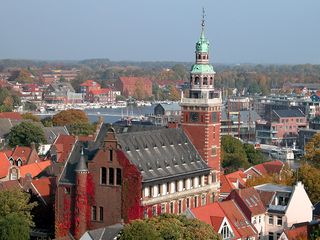
Leer is a town in the district of Leer, in the northwestern part of Lower Saxony, Germany. It is situated on the river Leda, a tributary of the river Ems, near the border with the Netherlands. With 34,958 inhabitants (2021), it is the third-largest city in East Frisia after Emden and Aurich.

Uslar is a town and a municipality in southern Lower Saxony, Germany, in the south-western part of the district of Northeim, and in the south of the hills of Solling forest which are part of the Weser Uplands.
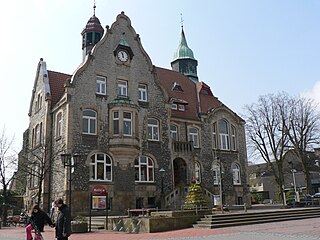
Melle is a city in the district of Osnabrück, Lower Saxony, Germany. The city corresponds to what used to be the district of Melle until regional territorial reform in 1972. Since then, Melle is the third largest city in Lower Saxony in terms of surface area.

Börger is a village and a municipality in the district Emsland in Lower Saxony, Germany. Börger is part of the administrative unit of Sögel.

Meppen is a town in and the seat of the Emsland district of Lower Saxony, Germany, at the confluence of the Ems, Hase, and Nordradde rivers and the Dortmund–Ems Canal (DEK). The name stems from the word Mappe, meaning "delta".

Bad Bentheim is a town in the southwestern part of Lower Saxony, Germany, in the district of Grafschaft Bentheim on the borders of North Rhine-Westphalia and the Netherlands roughly 15 km south of Nordhorn and 20 km northeast of Enschede. It is a state-recognized thermal brine and sulphur spa town, hence the designation Bad (“Bath”). Also to be found in Bad Bentheim is the castle Burg Bentheim, the town's emblem.

Haren is a town in Lower Saxony, Germany in the district of Emsland.

Emlichheim is a municipality in the district of Grafschaft Bentheim in Lower Saxony, Germany, roughly 20 km south of Emmen, and 25 km northwest of Nordhorn.

Wietmarschen is a unitary municipality (Einheitsgemeinde) in the district of Grafschaft Bentheim in Lower Saxony, Germany. It is split into the villages of Wietmarschen, Füchtenfeld, Schwartenpohl, Lohnerbruch, Nordlohne and Lohne with Lohne being the biggest and having the town hall while Wietmarschen, which is the second biggest, having the name.
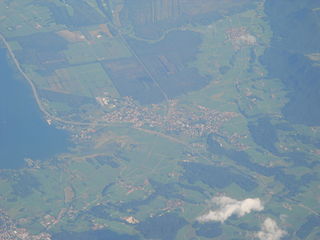
Bernau am Chiemsee is a municipality in the district of Rosenheim in Germany on the Lake Chiemsee, and a Luftkurort.

Lähden is a municipality in the Emsland district, in Lower Saxony, Germany.

The Heimathaus Twist is a cross-community cultural center in the municipality of Twist, Germany well known and for blues and folk music concerts nationwide.

The Erdöl-Erdgas-Museum Twist in Twist, Germany is a museum for crude oil and natural gas and shows technical equipment for mineral exploration of these natural energy resources and gives information about their geological origin.

The Internationaler Naturpark Bourtanger Moor-Bargerveen is a nature reserve in the west of the German state Lower Saxony as well as in the North-East of the Netherlands. Mostly this nature reserve is spread out over the German counties Emsland, Grafschaft Bentheim and the Dutch province Drenthe. The landscape within the nature park is characterised by big peat areas, heather, small lakes and a very low human population density. The Bourtanger Moor-Bargerveen International Nature Park was founded on June 1, 2006.

The Bourtanger Moor was a bog in eastern parts in the Dutch provinces of Drenthe and Groningen and the bordering German districts of Bentheim and Emsland. A remaining stretch on the border between Drenthe and the districts Emsland and Betheim is now a nature reserve, the Internationaler Naturpark Bourtanger Moor-Bargerveen.

